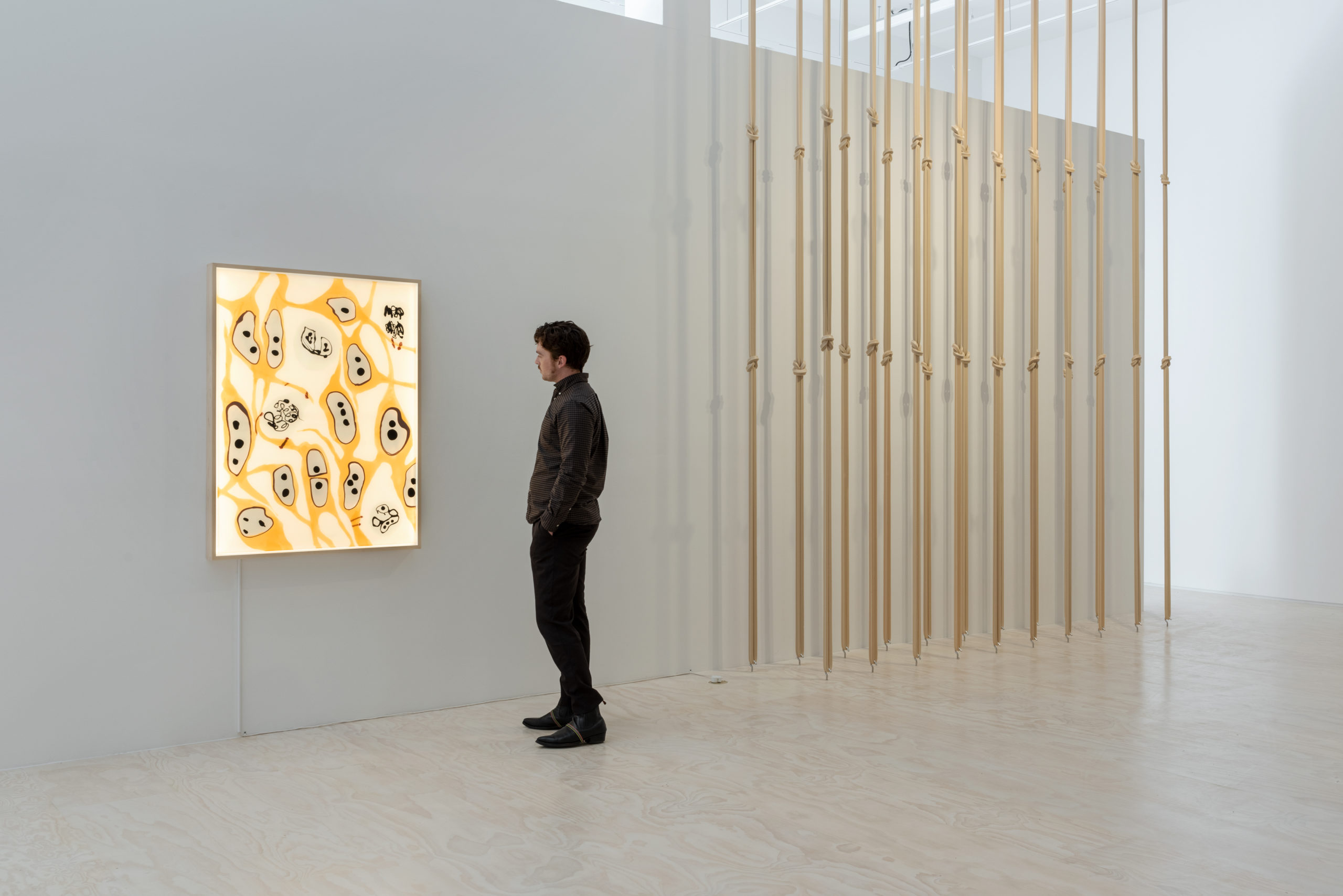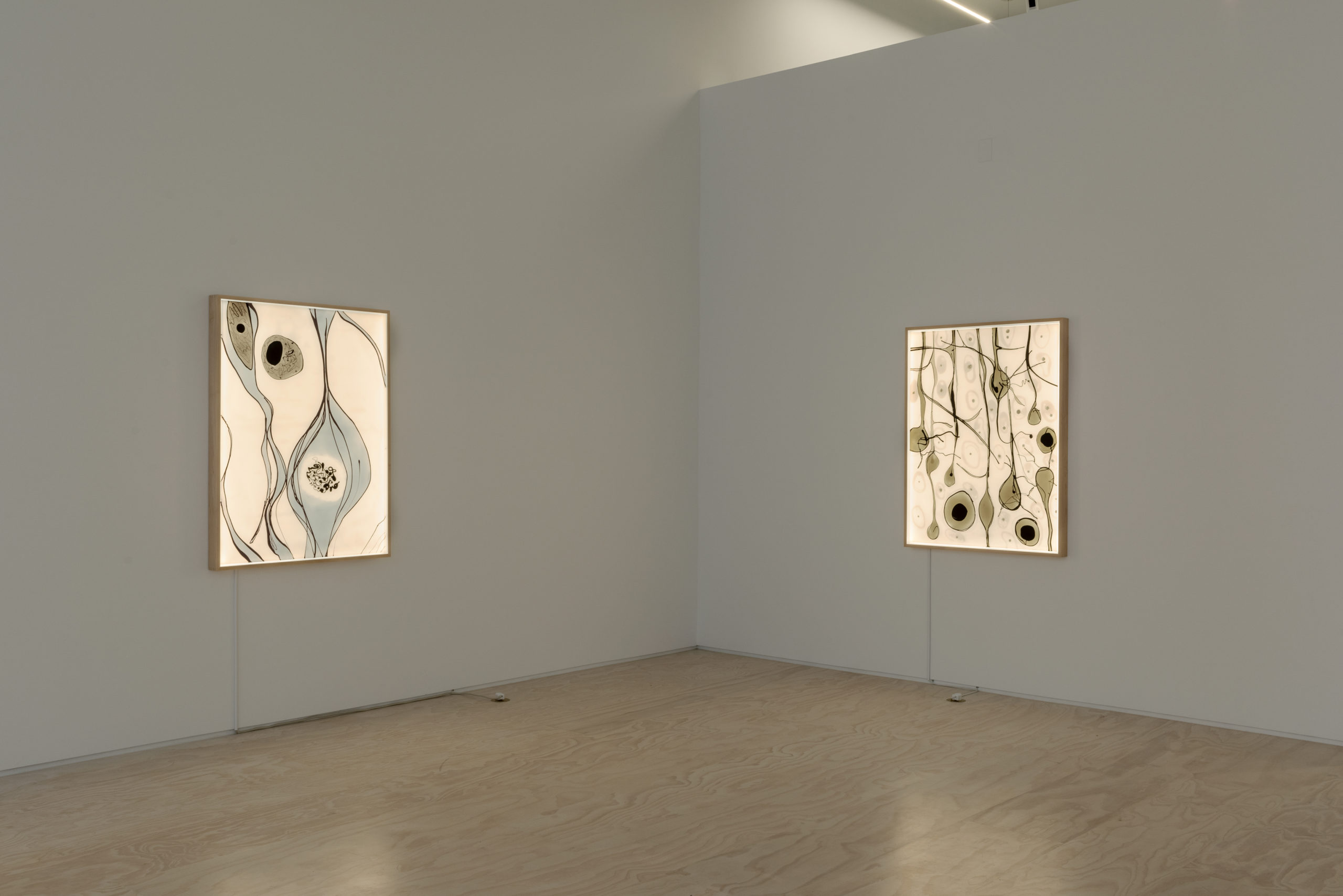
Installation view of “Brain in Hand,” Martha Friedman, Jessica Silverman, 2022; photo by Eric Ruby, courtesy of the artist.
“Martha Friedman: Brain in Hand” is on view at the Jessica Silverman in San Francisco through May 28. The show includes A Natural Thickening of Thought (2022), 10 lightbox cast rubber sculptures inspired by the microscopic neuron-drawings of the neuroscientist Santiago Ramón y Cajal. An installation, Rubbers (2022), hangs from the center ceiling, comprised of two rows of 10 six-foot loop-tied rubber bands, stretched and hooked to the floor, a tense taupe jungle. The show was activated by the performance Tenterhooks from dancer Silas Riener, staged on May 6 and 7.
Friedman was first drawn to the medium of rubber as a child in Detroit spending summers at an arts camp. The sculpture classes were relegated to a shack; there she plastered the trees in the Michigan wild. She liked casting for being equally mathematical and tactile, pulling form from form. Rubber presented a better tool, absorbing curves and peeling smoothly. Soon after she was sculpting with rubber as a form in its own right, beyond the forms it shaped. It was both mold and cast, liquid and solid, a fleshy and intermediary echo of bodily states.
In her work, Friedman always uses a secondary material—steel, concrete, glass—to “pressure” and incite the form. A Natural Thickening of Thought is encased in cast-rubber: spindly dendrites, amoebic outlines, and sloughed-off cells are sparsely and deliberately blotted with color like stains on a microscope slide, a portrait of the body on a scale which ensures no solid borders. Friedman conceived the wallworks in 2020, when she discovered the neurological illustrations of Ramón y Cajal.
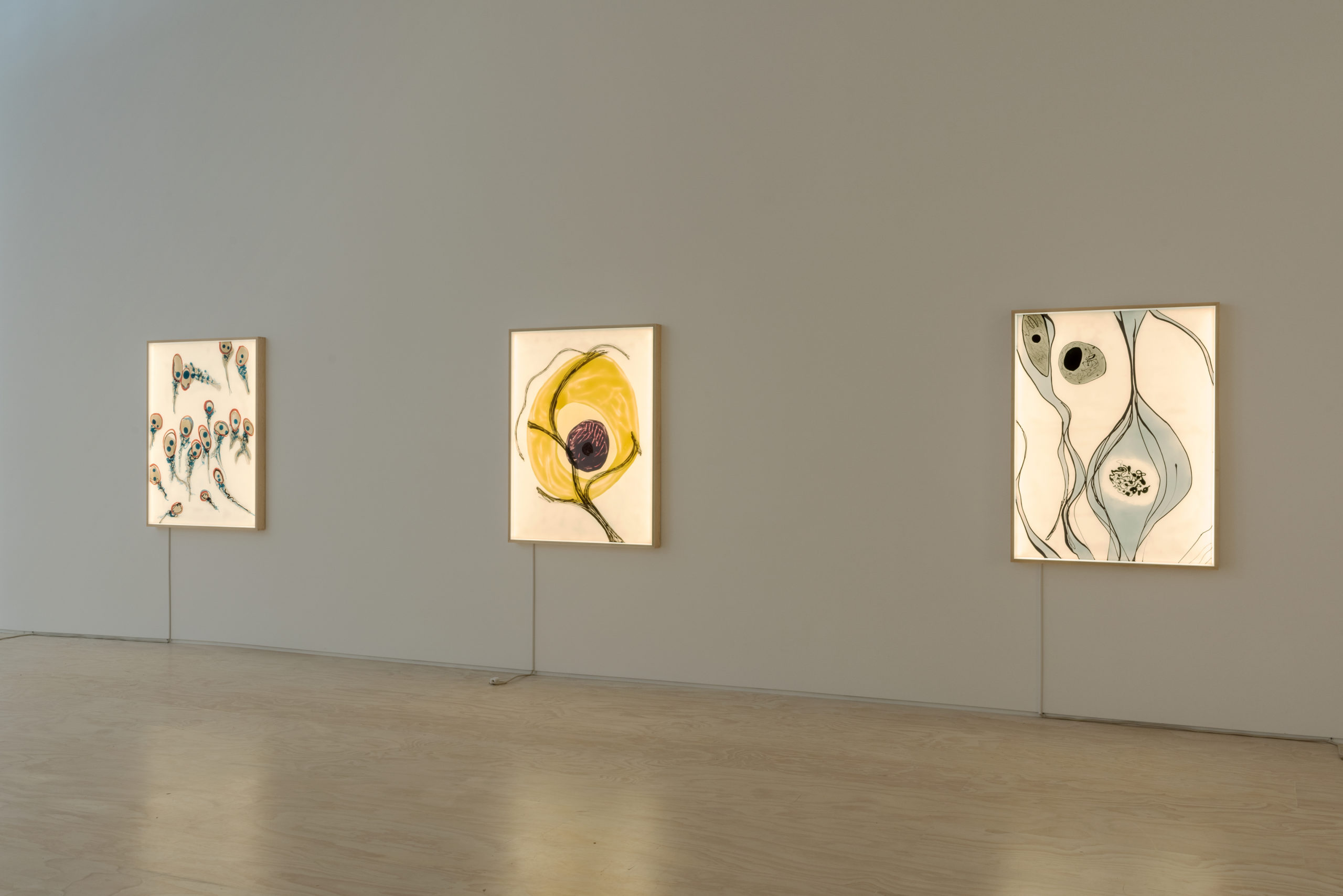
Installation view of “Brain in Hand,” Martha Friedman, Jessica Silverman, 2022; photo by Eric Ruby, courtesy of the artist.
The secondary material of Tenterhooks is the body itself, namely Riener’s. Friedman had exhibited preliminary versions of the project before meeting him in 2013. He was a dancer at the Merce Cunningham Dance Company assigned to perform Cunningham’s repertoire at Princeton, where she taught, a few years after the choreographer’s death. They were to use a Rauschenberg piece which Cunningham had used as backdrop, but last-minute loan complications prevented it. The director, knowing Friedman’s familiarity with the medium, asked her to create a 50-foot rubber wall. She poured, molded, hoisted, and stretched the flopping monument to movement (even sticking in a tire in tribute to Rauschenberg) until it caught the play of light from Riener’s body. Playing with a bag of rubber bands, they conceived of an installation. She presented multicolored variations of it in Detroit (2010) and New York (2012), but it never crystallized with a performance until this show.
With Riener’s background in performance and Friedman’s background in form, their work meshed at the question of bodily limits. Their collaborations before “Brain in Hand” were studies of stillness, materially dredging history through a still and searching lens. This culminated in Castoffs (2019), a Seattle exhibition of casts which Friedman made, broke, and reassembled of Riener’s contorted body. It was a matter of reversal on the one hand—the power dynamic of a female sculptor and a tortured male model—and virtuosity on the other, Riener’s poses reflecting the static dignity of the statuesque Greek and mummified Egyptian art historical canon.
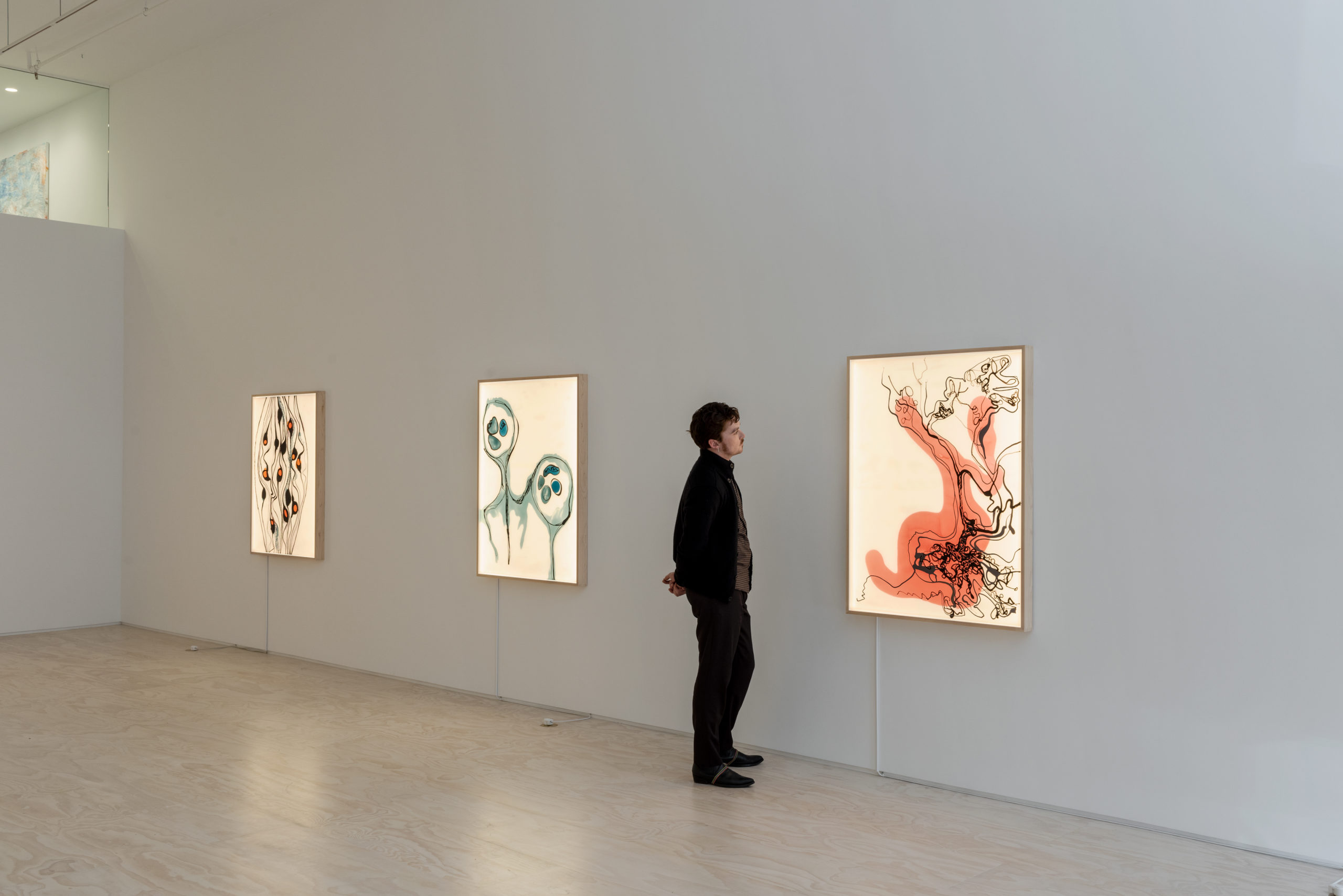
Installation view of “Brain in Hand,” Martha Friedman, Jessica Silverman, 2022; photo by Eric Ruby, courtesy of the artist.
No part of Tenterhooks, however, is static; it does not concern the limits of the body but the limits of body and mind. The performance begins with Riener, clad in a Spandex bodysuit the color of the bands, pushing through the rubber and passing through the interweaving gaps created by his pushing. He leans himself against the pendulums as they shake him, alternately frail and frantic. He unhooks the loops and subjects his body to the nooses that now hang above. He pulls the stretching columns back across the gallery until his ragged breath and hair practically touch the audience. He runs to vault the bands, swinging from loop to loop, launching on one leg and landing upon the other like a neurasthenic Tarzan.
He ties the rubber in two X-shaped teepees, branching at top and bottom hooks (now more threat than anchor, like a bed of nails) and bunched in the middle by other bands. After chalking his extremities with powder from a nearby bowl, he maneuvers himself above and between the strands until they wrap him like DNA, left limbs knotted in one helix and right in the other. Despite the continual silence of Riener and residual trembling of the bands, the room grows quieter and the rubber grows tenser and everyone is aware that this is the climax: he outstretches to a tree pose, strong but loose, trembling only as the bands tremble.
He lowers himself in a brutal swinging play of pulleys. The stretching squeal of rubber is punctuated by the rhythmic but unintentional thud of Riener’s knees, heels, and elbows against the backdrop wall. At this point a tertiary material—his sweat—makes this somewhat difficult and slightly dangerous. He gains the momentum to push himself downward and, grasping two floor-hooks with legs still knotted above, maintains this reverse pull-up until the drenched bands slip free by their own tension. The show ends with Riener released, reversed, and crumpled with his nape on the floor and back on the wall, the rubber gyrating above as in the beginning. It takes about 40 minutes. We asked him what sustained his performance, what he thought while snarled in all that shaking rubber. He said, “enhancement and confinement, extension and restriction.”
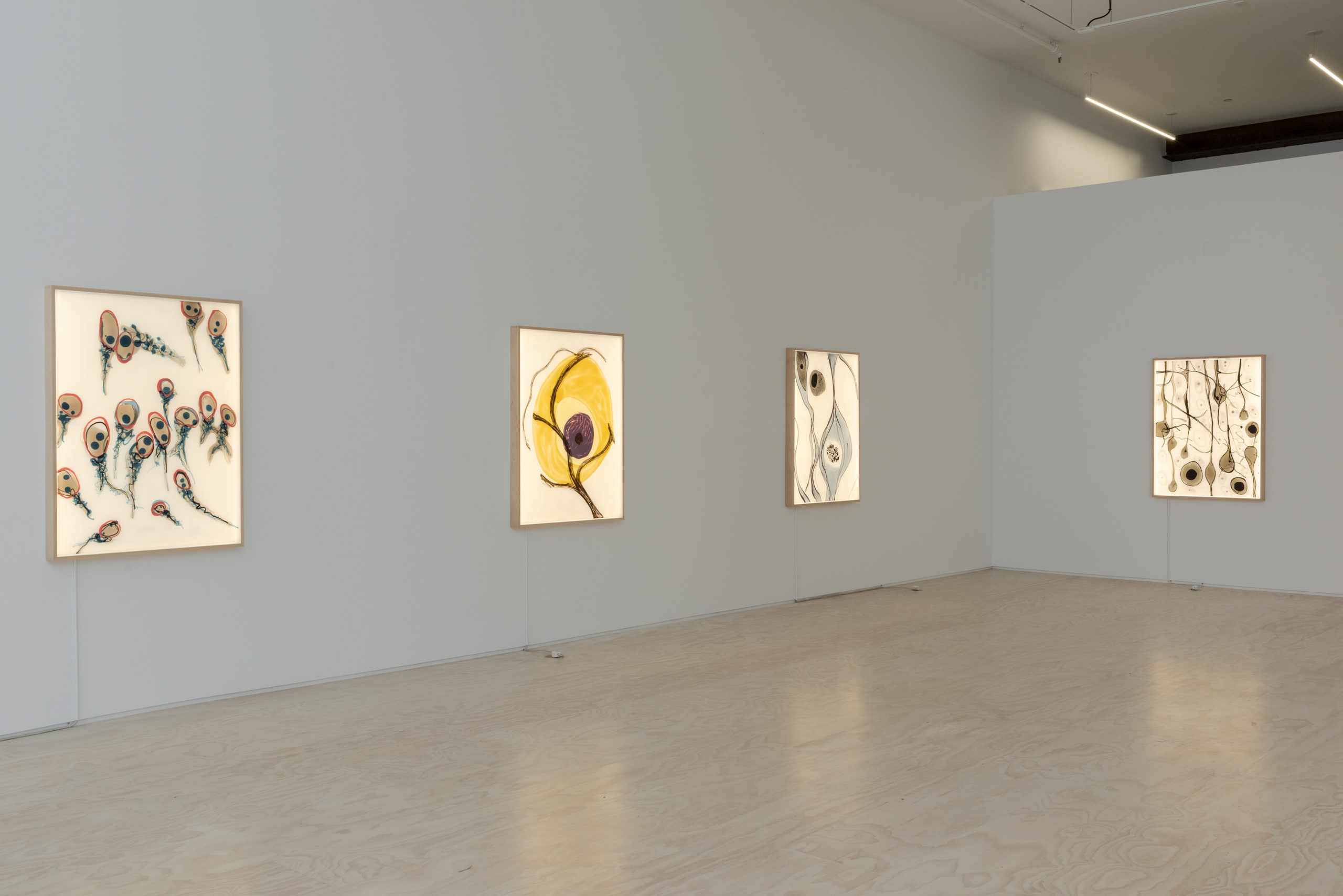
Installation view of “Brain in Hand,” Martha Friedman, Jessica Silverman, 2022; photo by Eric Ruby, courtesy of the artist.
The tension driving “Brain in Hand” is a matter of “where,” not freezing or surpassing bodily limits as in Friedman’s previous work but locating where one is within these limits—thoughts, stomach, skin, where within this liquid sac of neuron firings. As Riener animates the material, his body becomes the material. It is impossible to determine where the life-force ends and where the lived stuff starts, a feedback loop of embodiment, neurology, and the limits of form between the fluid flesh of rubber and the lean lines of Ramón y Cajal. Friedman told me that she realized during the trembling and tangled climax of Riener’s performance that, if she were to crop his body, she would see the living shadow of her Castoff sculptures. No concrete, no glass, the secondary material was the flesh reckoning with its image. Brain in Hand places this flesh within a dialogue of scale: the ever-moving borderlessness of the cell drawings and the ever-moving endurance of the bands become tools of the body’s influence, liquefying its bounds and solidifying its force. We asked her what the limit was now, what she felt she couldn’t escape? She said that it was her own work. Here is Friedman’s work interacting with itself.



